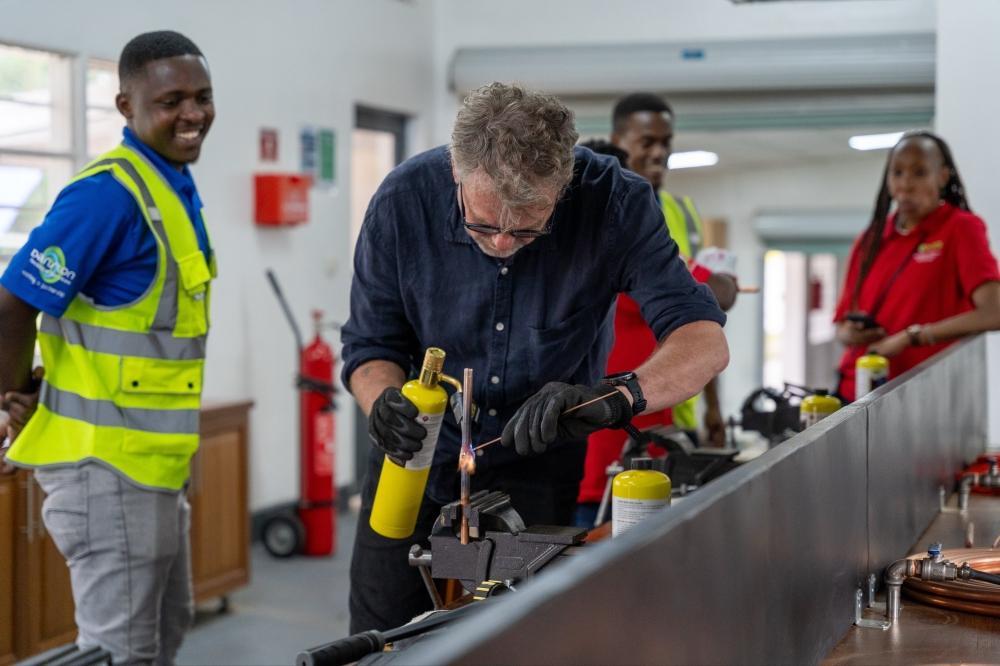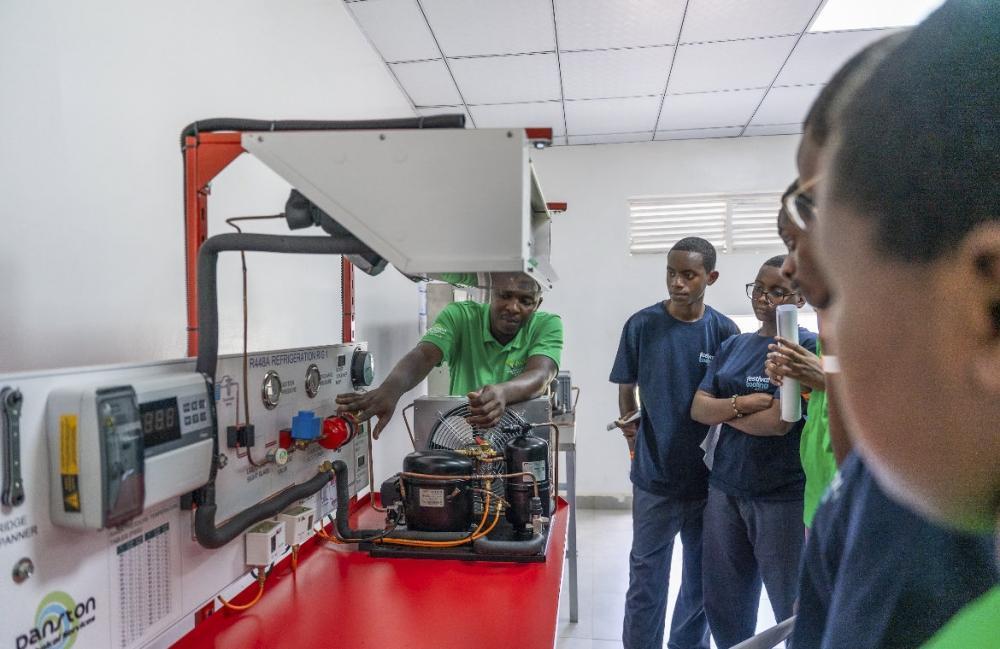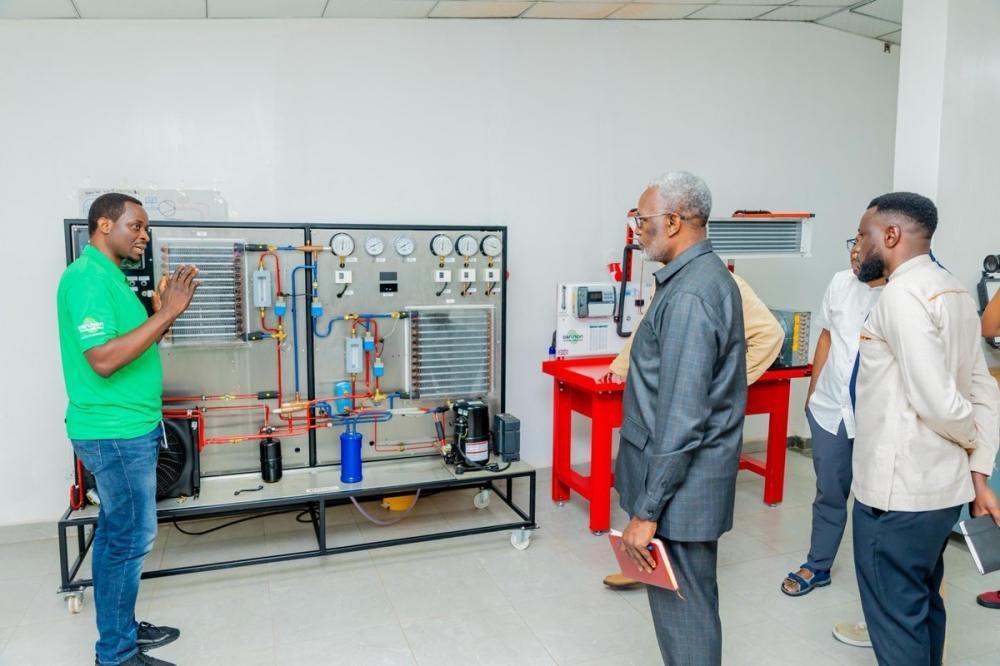Africa-Press – Rwanda. An Environmental Testing Chamber (ETC) by the Africa Centre of Excellence for Sustainable Cooling and Cold-chain (ACES) was showcased during the Vaccine Symposium, held from November 17 to 19 in Kigali.
The symposium brought together over 200 scientists, engineers, researchers, health policymakers, industry experts, and private-sector innovators working in human and animal health, as well as the environmental sector, from across Rwanda and the UK.
ACES, based in Kigali, Rwanda, serves as the first regional hub under the Clean Cooling Network.
The hub aspires to be a central and valued player driving the development of Africa’s cold-chain and cooling sector, while creating approaches and solutions that can be referenced, replicated, and adapted globally.
Basile Seburikoko, Technical Director at the Africa Centre of Excellence for Sustainable Cooling and Cold-chain (ACES), showcased the Environmental Testing Chamber and its impact on cooling technology in Africa.
What is an Environmental Test Chamber?
An Environmental Test Chamber, Seburikoko explained, is a controlled testing unit that simulates real environmental conditions such as temperature and humidity.
It is used to evaluate how refrigeration equipment performs under different climates and ensures consistent, repeatable, and accurate testing environments.
It supports compliance with international standards for cooling equipment.
It helps measure performance, energy consumption, reliability, and durability of refrigeration systems.
Importance of the ETC for the refrigeration sector
The testing chamber ensures refrigeration equipment performs reliably under controlled temperature and humidity conditions.
The Environmental Testing Chamber, Seburikoko explained, enables accurate evaluation of cooling capacity, energy efficiency, and durability, and helps manufacturers and technicians improve product quality and reduce failure rates.
It facilitates innovation in low-energy, climate-resilient, and solar-powered refrigeration technologies.
It also strengthens cold-chain reliability for food, agriculture, pharmaceuticals, and industrial cooling.
Technical testing standards
The +25°C ETC Class 3 is a commonly used international testing standard for refrigeration equipment.
Standard ETC Class 3 testing involves evaluating equipment at conditions of +25°C and 60% relative humidity.
Many countries use this standard to check whether fridges, freezers, or cooling devices can perform well under moderate ambient conditions.
The Environmental Test Chamber is capable of creating the specific temperature and humidity conditions required by international organisations and regulatory bodies to evaluate refrigeration equipment.
WHO requirements call for more extreme conditions of +43°C and 65% relative humidity to ensure reliable performance in hot climates.
With +43°C WHO conditions, the World Health Organization (WHO) requires more demanding conditions for equipment used in vaccine storage and medical cold chains.
WHO testing conditions often require +43°C temperature and 65% relative humidity.
This ensures that refrigeration equipment can maintain correct temperatures even in very hot climates, which is essential for safe vaccine storage.
“We must be able to test equipment under extremely high temperatures,” he said.
Testing across these ranges ensures that refrigeration equipment meets both global and regional operational standards.
The Environmental Testing Chamber allows for testing under Controlled Temperature Chain (CTC) conditions and above-standard stress scenarios, such as maintaining +40°C for four consecutive days, to verify equipment durability and suitability for real-world field environments.
Benefits to Rwanda and the region
The Environmental Testing Chamber (ETC), he said, reduces the need to send equipment abroad for testing and enhances local manufacturing and innovation.
“It supports regional cold-chain reliability for food and pharmaceuticals and promotes adoption of energy-efficient and low-emission cooling technologies,” he said.
Health sector impact
Seburikoko explained that the Environmental Testing Chamber (ETC) ensures reliable vaccine storage at precise temperatures, prevents spoilage of medicines and blood products, and supports hospitals, clinics, and mobile health units.
The testing chamber improves public health outcomes through safe cold-chain management.
Applications
The testing chamber supports a wide range of applications, including the evaluation of vaccine refrigerators and transport refrigeration systems to ensure they meet strict cold-chain requirements.
It is also used to assess commercial and industrial cold-storage units, as well as solar direct-drive refrigeration technologies designed for off-grid or energy-limited environments.
In addition, the chamber enables testing for energy efficiency and AI-driven optimisation, helping improve performance, reduce energy consumption, and enhance overall reliability across different refrigeration technologies.
“Environmental test chambers are critical for ensuring refrigeration performance, boosting energy efficiency, supporting health and food safety, and strengthening local and regional cold-chain infrastructure,” he added.
Environmentally friendly
This particular testing chamber uses R290, a hydrocarbon refrigerant.
R290 is valued for its excellent thermodynamic performance, which makes equipment more energy efficient compared to many traditional refrigerants such as R22 or R134a.
R290 has an extremely low global warming potential and zero ozone depletion potential, making it one of the most environmentally friendly refrigerants available today.
Energy efficiency
If refrigeration technologies are not manufactured in a sustainable way, they can be very disappointing.
“They use refrigerants, they use energy, and one of the major challenges is their energy consumption. It is disappointing when these technologies are not energy efficient. So we know if the imported equipment are truly efficient by using the testing chamber.”
There are Minimum Energy Performance Standards set by regulators, and these standards aim to bring more energy-efficient equipment into the country.
The same applies to refrigerants.
“The chamber allows accurate testing under international standards. We measure performance, energy consumption, reliability, and durability of refrigeration systems.”
Refrigerants impact the energy performance of the cooling system.
“For example, a system using R22 will generally be less energy efficient than one using R290. When we test equipment, we are not analysing the refrigerant’s chemical composition. Instead, we assess the impact of the refrigerant on overall system performance. Using two fridges of the same size—one with R22, one with R290—we can demonstrate how R290 is more energy efficient. So yes, refrigerants matter through their influence on performance.”
How testing is carried out
“We place a small fridge inside the chamber with a data logger to collect information on system performance. The room looks like a cold room, but it is not a cold room. We operate the fridge and collect various performance metrics. For instance, we can open the fridge and observe how quickly it recovers to the set temperature. All of this helps us understand how the system performs.”
For example, a fridge designed for use in Europe may be tested at 20°C ambient temperature.
That fridge may be labelled as Class A or A+.
But when brought to Rwanda, where ambient temperature is 28°C, it will not achieve the same energy efficiency.
“This is why the ability to simulate higher temperatures, even up to 50°C, is crucial.”
For More News And Analysis About Rwanda Follow Africa-Press









